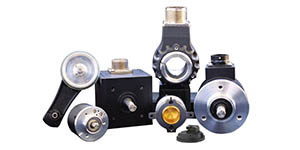The Basics of How an Encoder Works
 Before you can fully understand how an encoder works, you first need to understand what an encoder is and what it does. An encoder is a sensing device that provides feedback from the physical world; that is, it converts motion to an electrical signal that can be read by some type of control device, such as a counter or PLC. The control device then uses that signal to control a conditional event, such as activating a print head to create a mark at a specific location, or positioning a joint correctly on an articulated robot limb.
Before you can fully understand how an encoder works, you first need to understand what an encoder is and what it does. An encoder is a sensing device that provides feedback from the physical world; that is, it converts motion to an electrical signal that can be read by some type of control device, such as a counter or PLC. The control device then uses that signal to control a conditional event, such as activating a print head to create a mark at a specific location, or positioning a joint correctly on an articulated robot limb.
Encoders use different types of technologies to create a signal. Some common encoder technologies are: mechanical, magnetic, resistive, and optical. encoders may produce either incremental or absolute signals.
Incremental signals provide a series of high and low waves that indicate movement from one position to the next. there is no special indication provided by the encoder to show the specific position, only an indication that the position has changed.
Absolute encoders, on the other hand, use a unique “word” for each position, meaning that an absolute encoder provides both the indication that the position has changed, and an indication of the absolute position of the encoder.
Each encoder type has its advantages, but this paper will be limited to the most common type of encoder used today: optical incremental encoders.
Output Types
Incremental encoders are available in two basic output types: single channel and quadrature.
A single channel encoder, often called a tachometer, is normally used in systems that rotate in only one direction and require simple position and velocity information.
Quadrature encoders have dual channels (a and B) phased 90 electrical degrees apart. these two output signals determine the direction or rotation by detecting the leading or lagging signal in their phase relationship. Quadrature encoders provide high speed bi-directional information for complex motion control applications.
Resolution
Resolution is a term used to describe the Cycles per revolution (Cpr) for incremental encoders. each incremental encoder has a defined number of cycles that are generated for each 360 degree revolution of the shaft. these cycles are monitored by a counter or motion controller and converted to counts for position or velocity control.
If you still have questions about how an encoder would work in your specific application, or anything else encoder-related, give us a call. when you contact EPC, you talk to real engineers and encoder experts who can answer your toughest encoder questions. Contact EPC today to get the information you need.

